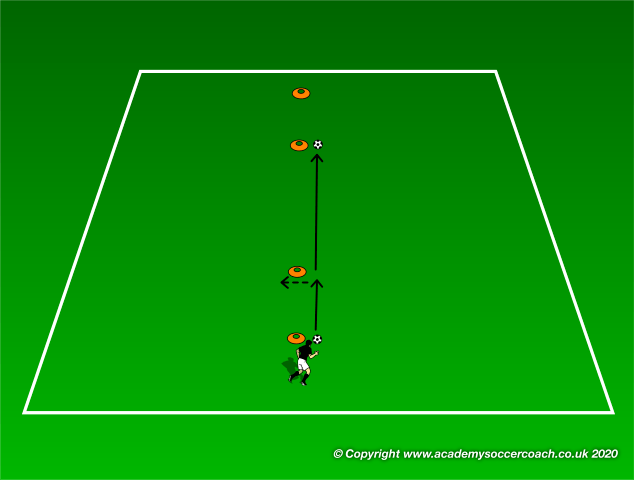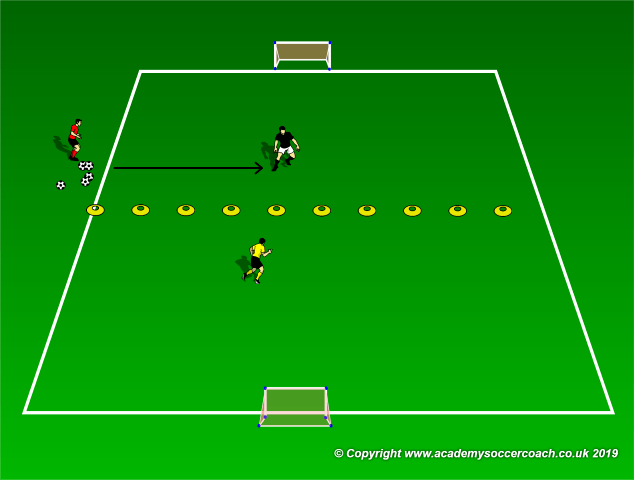- You are here:
- Home »
- Drills & Exercises
Category Archives for Drills & Exercises

3v1 Possession Drill
By Keith Scarlett –
Line a field into 4 15 yard boxes per the diagram.

Players are positioned in the grids as the diagram shows.

They play 3v1 for possession in their grid.

When the defender wins the ball, they immediately transition to the other grid and play in their two teammates. The player who lost the ball trails and plays defense in the new grid.

By Keith Scarlett

Competitive 1v1s to Goal
By Keith Scarlett –
Setup at the halfway line as in diagram below.

Once ball is played forward and the first person in each line takes off after it.

The player who gets to the ball first has to stop for one second, and then goes 1v1 against the defender as quickly as possible.

By Keith Scarlett

Interval Sprint Dribbles
By Matt Carroll –
The purpose of this individual technique has two main purposes. First is to increase sprint speed by allowing for recovery between sprints to ensure that they are done at max capacity. The second is to help players begin to increase their ability to receive the ball at high speeds.
Setup:
Set up four cones creating three lines. The first line should be 10 feet, the second 20 feet, and the third 10 feet. Players line up at the first cone with a ball. A ball should be set up at the third cone.

Execution:
Players start by dribbling with their right foot on the right side of the first cone. Once they reach the second cone the lightly play the ball to the left of that cone and then move in a dead sprint to the third cone. They should not slow their sprint down until they have passed the third cone and gained control of the ball, this is to simulate receiving at full speed.

They then begin to slow down and take as many touches as possible while moving slowly towards the fourth cone. Once they round the fourth cone they should move to playing with their left foot back to the third cone and repeat the process they just did on the other side.

The process should be repeated anywhere between 5-8 times. Players should go slowly during the dribbling portions to the point where they are no longer out of breath when they reach the sprint area so they can sprint at maximum capacity.
Variations:
The type of dribbling done during the dribbling areas can be varied based on purpose or skill. Length of sprint and dribble zones can vary as well.
By Matt Carroll

Active Shooting Drill
By Keith Scarlett –
Place cones and balls as in diagram below.

One player starts off with the first cone opposite the pile of balls.

This player then runs around the first cone, receives a pass and takes a shot on goal.

They then repeat this step around each cone.
By Keith Scarlett

Short and Simple Fitness Drill
By Keith Scarlett –
Two rows of cones 10 yards apart, staggered.

Player starts at the front left cone and sprints to the first cone in front of them.

The player then backpedals to the cone back and to their right.

They then sprint to the cone that is now in front of them.

They repeat this sequence but now going to their left, then again to their right, etc…until they have run the entire course.
By Keith Scarlett

1v1 to Two Goals
By Keith Scarlett –
One 20 x 20 yard grid split into 2 10 x 10 yard grids.

Players play 1v1 in the large grid. There is a neutral player with balls outside of the grid.

The neutral player plays a ball in and the attacker tries to get to it first and attack one goal, while the defender tries to defend.

By Keith Scarlett

3v2 vs 3v2
By Matthew Carroll –
Description ; The 3v2 vs 3v2 drill can be used to either focus on the attacking players or the defending players. With the focus on the attacking players the teaching points can be moving with pace to take advantage of numerical superiority, scoring off numerical mismatches, or counter pressing. If the focus is on the defending side the focus can be on transition moments, staying compact, and building out the back.
Setup: Create a field appropriate for two 3v3 games back to back to each other with a small goal on either end and the field divided in half. Set up two teams of 5 and place three attacking players on one end of the grid and two of the team as defensive players on the other end. Place extra balls in or around each net for transitions.

Execution: Play starts with one of the attacking teams of three starting against the oppositions team of two defenders. The attacking team attempts to score, if they do the defenders retrieve a ball from the net and must pass it to their attacking players on the other side.

If the defending team intercepts the pass or the shot misses the goal the defenders still attempt to pass to their attacking players, but now the opposition attacking team can attempt to defend them and win the ball back to try and score. Play continues until a designated time elapses or a score is reached.
Variations: The number of players can be varied depending on the skill/availability of players, as long as the advantage is kept by the attacking side. Goals size can be increased and goalies added as the number of players increases.

By Matthew Carroll

Possession Then Long Passes
By Matthew Carroll –
Description: The long and short game is designed to help players understand the importance of maintaining possession in order to create opportunities to play more direct or dangerous passes. The short passing option in this game requires skill but is much more forgiving if a mistake is made. The long passing option is more rewarding but requires more skill and accuracy with few chance of success, simulating a realistic game experience.
Setup: Create a grid with four cones in a rectangle. The halfway point between each side should be marked off with a cone. Between the long sides, halfway, cones or coaching sticks should be placed to create a gate. Four cones should be placed in the middle for four defenders to stand on. The rest of the players should be lined up at the four outside cones.

Execution: Play starts when a player at one of the cones passes to the cone to the side of them (they cannot pass to the diagonal cone) and the passer follows their pass to the end of the line at the cone that was passed to. The ball must travel halfway to its target and then the defender in the middle can go and attempt to steal the ball. If they are able to win possession the player that was intended to receive the ball must become the defender. If the pass is received the receiving player then can look to pass back where the ball came from, or the option to their left/right.

The unsuccessful defender must return to their cone at a jogging pace, but if the ball comes back to their side, as long as they were making an effort to return to their cone, they can go and defend a pass in their area without returning to their cone.

Variations: The length of the sides can be varied by age, ability, and intended result. The number of touches by the receiving player can also be modified to increase/decrease the difficulty involved.
By Matthew Carroll
